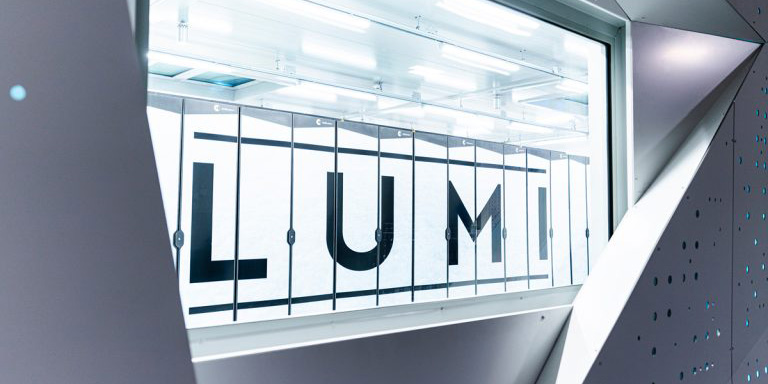New Finnish LUMI projects announced: AI innovations in healthcare and beyond
The fifth batch of Finnish research projects to utilize LUMI, Europe’s fastest supercomputer, have been chosen, and will run on the system using its massive GPU capacity. The projects are, for example, advancing healthcare with foundation models for cancer diagnosis and treatment, and radiology. A total of six new projects to run on LUMI were chosen in the fifth Finnish LUMI Extreme Scale Call, which shared resources from Finland’s country share of the LUMI resources.
The accepted projects are:
ALVS: Active Learning for Vibrotational Spectroscopy, PI Patrick Rinke, Aalto University, co-PI Ondrej Krejci, Aalto University
This project will help investigate and improve the heterogenous catalysis of green fuels, such as methane and methanol. Heterogeneous catalysis is an important industrial process that produces useful chemical compounds (e.g. green fuels), and converts unwanted chemicals like CO2. In this context, it becomes essential to understand the catalyst’s behaviour and working mechanism. Vibrational spectroscopy is one of few characterization techniques that can provide in-situ and real-time information on catalyst operation. The researchers will create and train a machine learning model predicting vibrational spectra.
DYNSCON: Dynamos in stratified and rotating convection with low Prandtl numbers, PI Maarit Korpi-Lagg, Aalto University, co-PI Jörn Warnecke, Max Planck Institute for Solar System Research
The group’s studies relate to the formation of solar storms. Solar storms occur when the magnetic fields inside the Sun rise to the surface, become stronger and generate coronal mass ejections or flares. However, the mechanism of a solar magnetic field is still poorly understood. This project is continuation to the research group’s earlier projects on LUMI, simulating dynamo processes in the deep stellar convection zone. Previous projects have revealed findings that require LUMI’s computing capacity for further investigation.
– The roots of all these disturbances are located in the convection zone under the Sun’s surface, which our group studies. It is difficult to predict the most energy-containing eruptions because disturbances travel close to the speed of light, Korpi-Lagg said about the group’s research in an interview.
The group is developing methods to monitor sub-surface changes. These could possibly give as long as a couple of days more time to react to the solar storms.
Have also a look at a video where Maarit Korpi-Lagg tells about her research.
EXPAND ATMOS: Expanding property prediction and machine learning models for atmospheric science, PI Patrick Rinke, Aalto University, co-PI Hilda Sandström, Aalto University
This project will advance the understanding of particle formation and the effects of human emissions on climate, as well as enable the development of novel computational tools using AI.
Aerosol particles impact climate and air quality. The particle formation process involves numerous compounds, which form from molecules emitted into the atmosphere. Insights into the effects of human activities on climate change can be gained from a better understanding of molecular level particle formation. However, experimental identification of organic compounds taking part in particle formation is challenging due to their volume and variability.
Computational tools have emerged that can identify key species in particle formation by e.g., prediction of molecular saturation vapor pressures (pSats). This project extends this framework by predicting pSats for new atmospheric compounds. The pSat dataset helps to identify potential particle-forming molecules and to develop AI methods for property prediction.
LumiLLM Experts: Lumi Large Language Model Experts, PI Sampo Pyysalo, University of Turku, co-PI Jonathan Burdge, Silo AI
This project is a collaboration project between University of Turku and Silo AI, leveraging the open, state-of-the-art large language models (LLMs) developed in the group’s previous LUMI project. Researchers in this project will explore innovative approaches to further enhance the performance and capabilities of generative AI systems with a European multilingual focus. The new methods used in the project not only promise to advance the state-of-the-art in open LLMs in general, but also create new opportunities for creating models tailored for specific applications to address unique challenges in fields such as healthcare. The project will further contribute to the AI research community by sharing insights, methodologies, and potentially novel architectures that emerge from the research group’s experiments, fostering innovation and collaboration in the field.
MFM: Medical Foundation Model, PI Guoying Zhao, University of Oulu, co-PI Wei Peng, Stanford University
The integration of deep learning in healthcare faces challenges due to data annotation complexity and model generalization issues. Foundation models, pretrained on vast datasets, offer a solution by reducing the need for annotated data and enhancing model robustness. This project aims to develop a Medical Foundation Model (MFM) to provide generalized features for various radiology tasks, especially in data-limited scenarios. Evaluation will span modalities (CT, X-ray, MRI) and tasks (diagnosis, segmentation) to measure MFM effectiveness and generalizability, with the overarching goal of advancing healthcare delivery.
PANENCODER: PanEncoder – a multi-tissue foundation model for digital histopathology, PI Esa Pitkänen, University of Helsinki, co-PI Tuomas Mirtti, University of Helsinki
This project aims to develop methods for accurate and earlier detection of clinically significant prostate cancer and find correct treatment decisions for an individual patient. A key tool to achieve these aims is digital histopathology, generating massive amounts of imaging data. Here the research group proposes to extend their foundation model called HistoEncoder for prostate tissue histopathology to a pan-cancer setting. Training these PanEncoder models on massive, multi-tissue imaging data, the researchers aim at state-of-the-art results in multiple, clinically important tasks such as diagnosis and prognosis prediction, and treatment choice. This project hopes to improve the accuracy and equality of cancer detection and treatment on a global scale, making these pre-trained foundation models freely available for the community, similarly to the previous HistoEncoder model. The societal objective is to advance health care and increase the quality of life of the patients.
